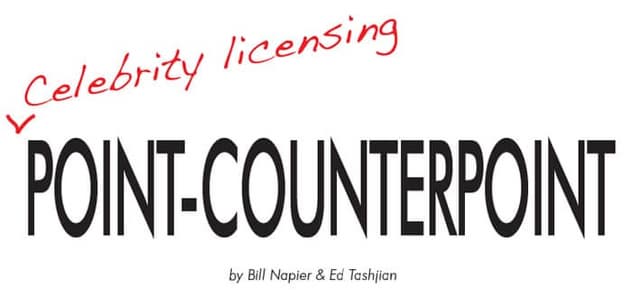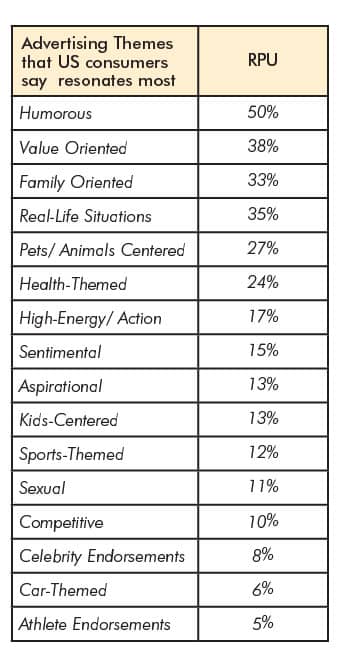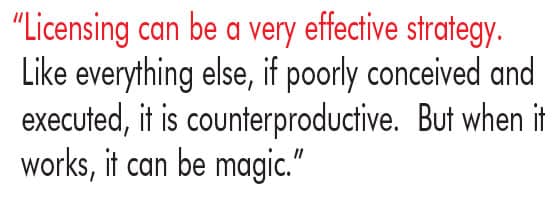
Is the licensing of celebrity furniture lines in the home furnishing’s category worth the cost for manufacturers and retail brands? Two marketing experts explain their differing points of view.
Furniture World asked the question at left to marketing experts Bill Napier of Napier Marketing Group and Edward Tashjian of Tashjian Marketing and asked them to duke it out. Bill doesn’t think it’s a great idea for many companies but his friend Edward Tashjian differs. We’ll let each have their turns, and will let you, the reader decide!
Point Napier
Bill Napier: Almost daily I read that another home furnishing company is licensing a celebrity of some sort, Chef, Singer, popular Home Makeover TV Host, etc… to promote its products and brand, especially now before major furniture markets.
My first thought is; Why would they do that? Sure, these celebrities benefit from the exposure and the revenue that brands/licensees provide, but I can’t help but wonder if the brands receive the same exposure and the consumer connections they hope for as a result.
Then I thought back to all my RANTS on http://www.napiermkt.com/retail-rants-blog about the lack of, or complete abandonment of manufacturers investing in and promoting their own companies as “brands”. And more importantly, using their resources to help their retailers get velocity on the products they floor of those brands. Personally, I think I’ve made the case over and over that our industry considers true marketing to be for the furniture markets only, at the expense of investing in branding focused on helping retailers and convincing consumers.
Let me explain why I think this is a problem for our industry.
Let’s start with your target audience, the people that actually have the money to buy your products, the 34-64-year-old age group. This demographic includes the Millennials who are so important to the survival of any home furnishings enterprise. Recent research from The Nielsen Company (Global Trust in Advertising Report, Sept 2015) identifies “winning strategies for an evolving media landscape,” found that, US consumers are big fans of humor (score one for Alec and Lil’); however, the study says that celebrity and athlete endorsements are two of the three themes that resonate the least”. The survey found that celebrity endorsements resonate with just 8% of US consumers (see chart below).

Based on this study, the best options for marketers to look at are; Value, High Energy, Aspirational and Humor before handing off their brand to some person whose personality and actions could become detrimental to their investment with a single tweet, comment, political position, moral or ethical faux-pas that might disrupt brand good will.
What’s The Cost?
- Not all license deals are the same. Some are very expensive, but the ones I’ve worked with, usually hover around minimums/guarantees of approximately $1,000,000 against the wholesale dollars and this could be for 1-3 years! Once that minimum is met, then the celebrity could be looking at 1% - 10%+ of every sale. I wonder what would happen if these home furnishings producers invested in their own brand and in the retailers who support them with this type of investment. BUT that’s not all of the costs. There can be travel expenses, appearances, social interactions and others. So why would a manufacturer do this?
I’ll explain what I think, and it may be a bit brutal, but I’ve been there/done that.
- Rationale #1: “They are famous and we are not. This will elevate us in the buyer’s mind at markets to come see us.”
- Rationale #2: “The celebrity has a huge social media following and we can gain traction with that.”
- Rationale #3: “We get huge traffic and we get placements from the buyers at markets.”
My answer to #1 is, manufacturers need to invest in their own brand so that their retail customers can get sales velocity. This investment needs to include the basics such as product videos, P.O.S., social media, blogs, a great website and so much more.
Even if some of your customers care about celebrities who are endlessly highlighted in magazines, tabloids, and on TV, are you sure that this interest will translate into sales?

My answer #2 is that most brands in this industry have lousy websites, and social/blogging platforms that are virtually non-existent. When manufacturers partner with celebrities they must ask themselves, whose brand gets the attention? There are a handful of manufacturers in our industry that have done this well, because they co-branded extremely well. They’ve thought it out to insure they took advantage of the opportunity to support their retailers with a variety of tools for increased velocity.
My answer #3 is OK, I’ll give you that because in the last 16 years of attending market, there really isn’t any “BUZZ” except about a new country singer, celebrity chef, home makeover person or something. Believe it or not, the “person” gets all the advertising, while the Brand and the product play second or third fiddle to their name.
The Bottom Line
So I ask you, after the initial introduction and placement, what are the numbers over one year, two years, three years? Are the placements and more importantly the sales velocity, worth the cost of those licensing fees? And, has this licensed product cannibalized sales from other collections and SKU’s? If so, there’s a HUGE problem when the agreement ends, because all the investment, all the attention has been funneled into the celebrity brand; not into the manufacturer’s or retailer’s brand. And, when the term of the agreement is over what can be done? Renew or buy another or start all over again of course.
As a marketing person for over 30 years it was my job to do the research, due diligence on the research, formulate a plan, articulate the plan and execute the plan with input and insights from employees, salespeople, outside vendors and more. I don’t see a lot of furniture marketing people doing that anymore. Sure there are a few really good ones, but believe me, not nearly enough.
In Summation
If you’ve read this far, you’ve probably figured out that my view of most celebrity “designed” or endorsed home furnishing products are not well researched, not well articulated as a brand, not well executed, very expensive and most importantly… are not worth the investment because, as the research shows, there are so many other ways, better ways, to get consumers to have an interest in and buy home furnishings products.
Counterpoint Tashjian
Bill makes some good points, but don’t throw out the baby with the bathwater. There is no such thing as always or never. Without question there are plenty of ill-conceived licensing arrangements that are a waste of resources, but there are many that make sense. The key is to know the difference before you jump in with both feet. I will provide a checklist, but first let’s examine the three primary objectives of marketers at the various markets.
- To develop and bring to market differentiated products with real or psychological differences.
- To get those products brought to the various markets placed at retail.
- To facilitate the sell-through of those products at retail.
The right partnerships can make a world of difference in each of these areas. With more than 2,000 exhibitors introducing new products at least twice, and some as many as four times a year, it is extremely difficult to stand out. This is especially true in a category that is driven more by fashion than technology. Many of what Bill referred to as celebrities are in fact bona fide designers with extraordinary talent and creativity. For example, take Richard Frinier for Century Outdoor and Brown Jordan. He is the quintessential outdoor designer that redefines the category with style and innovation (which is why he was inducted into the Hall of Fame this October.)
Lifestyle brands like Tommy Bahama or TV celebrities like Joanna Gaines (Magnolia Home), bring something to the table that no one else can. I recently conducted surveys with several top retailers about this topic. Dealers have mixed feelings about licensed brands. They believe the key drivers are product and value and the license is just the frosting on the cake. But nearly all feel they need to have them and in fact buy them regularly.
Different channels need different partners. Middle-market stores need middle-market licenses. They loathe the high-end designers, but are attracted to well-known names, especially when they’re known for their expertise in the home, like Joanna Gaines. Aside from the cachet of the name, what retailers like about them is that they often come with manufacturer commitment and energy as well as marketing which includes both lifestyle photography and personality photography drawing interest and differentiating their store both in advertising and at the point-of-sale.
Getting products placed in the marketplace is another challenge. There is a limited amount of floor space. I estimate that the products shown at market is anywhere from 50 to 100 times what can actually be placed at retail. There are 11.5 million square feet of show space in High Point alone. Even the most efficient buyer, there for seven days can visit only 70 exhibitors per market. Rachael Ray has wide distribution. Without her endorsement I doubt Legacy Classic would have achieved those placements. A primary goal of competent furniture marketers is first to get people to their showrooms. Does a celebrity magnet help? You bet it does. Anyone who is ever done this successfully knows that the right license brings in new customers and you can double normal showroom traffic whether it’s the result of vanity or real product differences.

A license almost always leads to better marketing at retail because there is a contract that requires it. Yes, in a perfect world, manufacturers would add a 10% advertising royalty or marketing fee to their OWN bill of materials. Nearly every other industry does this to support their marketing efforts. Here’s why furniture manufacturers don’t. The barriers to entry and the real product differences in this category are very low. There are certain merchandising price points that manufacturers need to hit. If they don’t, there are plenty of competitors that do. And, a manufacturer is lucky to make a 5% net operating profit. Their thinking is, if they put this into marketing they won’t make any money at all. Without something special like a license, they can’t reconcile the premium price.
Having the license forces manufacturers to build marketing into the cost. Along with the new products, there is advertising, point-of-sale, in-store events and training that come with the territory–which are often the real differentiators!
Not all licensees are created equal. Some are great and some are lousy. Both retailers and manufacturers are well advised to know the difference before they buy in. Allow me to share my top 10 checklist of criteria for knowing the difference.
Top 10 Licensing Checklist
1. Fill a profitable design niche. A common element of all successful licensing programs is good product, which meets an unfulfilled lifestyle niche. The licensor should bring something special to the table in terms of design, marketing or brand equity.
2. Increased placement. A license should allow you to open more doors, increase square footage on existing floors, or bring new customers (Example: a younger demographic or a new channel of distribution).
3. Support higher prices and margins. Your margins must increase by a minimum of the licensing fee plus 20% to cover extra costs.
4. Extend a product life cycle. The licensed brand should be of an enduring nature which allows you to add products and extend a product life cycle.
5. Be consistent with your brand positioning. For example, if you stand for fashion leadership, your licensed brand should be of a design nature, or have the ability to enhance displays.
6. Have a strong Social Media following. Social media is continuously evolving, and each medium has its own special audience. The partner must have a strong following, a contractual agreement and a plan to promote the products on an ongoing basis.
7. The licensor should appeal to each of your constituencies. Interior Designers, Buyers, floor design associates and end consumers. There needs to be a reason why everyone can get excited by it.
8. Be a logical and believable fit. Make an easily understandable, authentic connection.
9. The Licensed brand should be better known than yours. You are licensing the equity in a brand which has already been built, vs. using your marketing dollars to build their brand.
10.High Quality Partners. Your partners should bring to the table a stable staff of intelligent, creative, available and responsive people, who help you to grow your business.
Licensing can be a very effective strategy. Like everything else, if poorly conceived and executed, it is counterproductive. But when it works, it can be magic.
About Ed Tashjian: Ed Tashjian is Principal of Tashjian Marketing, a strategic marketing and business development consulting firm based in Hickory, NC specializing in the home furnishing’s industry. Find out more information at www.Tashjianmarketing.com or call (828) 855-0100.